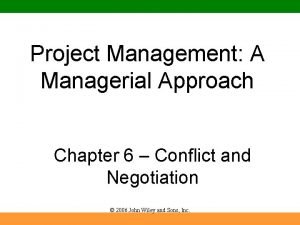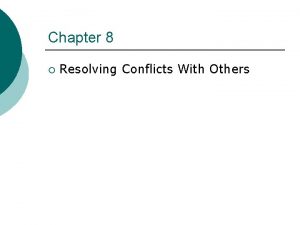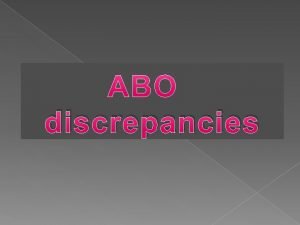3 Resolving consumer conflict Non legislative and legislative


















- Slides: 18

3 Resolving consumer conflict Non – legislative and legislative methods Sales of Goods and Supply of Services Act 1980 Small claims procedure Consumer protection Act 2007 National Consumer Agency

Chapter 3: Resolving consumer conflict: legislative methods Resolving Consumer Conflict • Both consumers and employees have rights • Conflicts need to be resolved • Legal methods may be needed if other methods fail

Chapter 3: Resolving consumer conflict: legislative methods Resolving consumer conflict • Both seller and buyer have responsibilities • Caveat emptor – ‘let the buyer beware’ § Consumers should not spend their money in a way they will later consider to be unfair • Problems facing consumers § Poor quality goods (e. g. from mass production) § Poor after-sales service § Misleading advertising (e. g. selling prices)

Chapter 3: Resolving consumer conflict: legislative methods Steps involved in resolving conflicts in a non-legislative manner Know you rights: • Always be aware of your rights as a consumer and try to deal with people in a conciliatory and friendly manner, even when you feel you have been badly treated. Make contact: • Make contact with the retailer in person, by telephone or by email. Make an appointment: • Make an appointment to see a representative of customer services. Use this meeting to discuss the situation and come to an acceptable solution Negotiate Compromise: • If necessary, negotiate a compromise solution that is acceptable to both Third party: • If direct negotiation is unsuccessful, seek advice from, or the services of, an independent third party such as the Consumer Association.

Chapter 3: Resolving consumer conflict: legislative methods Steps involved in resolving conflicts in a legislative manner In Irish law there are two main pieces of legislation designed to protect the consumer: 1. Sale of Goods and Supply of Services Act 1980 2. The Consumer Protection Act 2007

Chapter 3: Resolving consumer conflict: legislative methods Sales of goods and supply of Services Act 1980 (part 1) Goods The 1980 act gives consumers certain legal rights regarding Goods: § Merchantable quality: fit for normal use § Fit for purpose e. g. waterproof jacket should keep out the rain § As Described: Sale by description - goods should match the description e. g. Argos § Correspond to sample: if goods are sold by sample, they should match the sample § Ownership and quiet possession: seller has legal right to sell § Contract for the sale of vehicles: vehicle must be roadworthy and free from defects. § Guarantees: extra owner protection for period of guarantee § Unsolicited goods: illegal to demand payment for these § Conditions: if conditions not met, buyer can refuse to accept contract § Warranties: minor part/statement in a contract

Chapter 3: Resolving consumer conflict: legislative methods Sales of goods and supply of Services Act 1980 (part 2) Services • The 1980 act gives consumers certain legal rights regarding services § Supplier must have qualification or skill to provide service § Service must be provided with due care and attention § Materials must be of merchantable quality • The retailer is responsible for sorting out consumer complaint • If products are faulty, consumer can choose any of the following redress (solutions) § Repair § Replacement § Refund

Chapter 3: Resolving consumer conflict: legislative methods Signs limiting liability are illegal

Chapter 3: Resolving consumer conflict: legislative methods Small Claims Procedure • Consumers can make claims for faulty goods or services • Claims must not exceed € 2, 000 • Two parties to a claim § Applicant: person making the claim § Respondent: person against whom claim is made • Resolves minor disputes without expensive legal costs • Most claims relate to holidays, electrical goods, dry cleaners and professional services • Small Claims Procedure can’t enforce judgment but does have the majority of its recommendations accepted • If the respondent chooses not to accept the recommendations then they can have the case heard in the District Court • http: //www. courts. ie/Courts. ie/Library 3. nsf/pagecurrent/224 D 3 F 40 A 61421 D 2802 56 DA 6002 EB 56 B? opendocument&l=en

Chapter 3: Resolving consumer conflict: legislative methods FAQ’s I recently bought a second-hand car but it frequently breaks down. I’ve brought it back to the garage but the problems keep arising. What should I do? In the case of a second-hand car you still have rights under the Sale of Goods and Supply of Services Act, 1980. A second-hand car would, however, be expected to have some wear and tear. Therefore obtaining redress may be difficult; for example, the age and mileage on your car will be taken into account.

Chapter 3: Resolving consumer conflict: legislative methods FAQ’s Do I have to accept a credit note in place of faulty goods rather than a refund? A refund returns the payment to the consumer. A credit note is like a voucher - it can only be redeemed in that retail outlet and, in some instances, if the shop is part of a chain, in that chain of shops. This will depend on the terms and conditions. You should carefully consider the terms of a credit note before accepting it. You do not have to accept a credit note as a form of redress where the goods are faulty.

Chapter 3: Resolving consumer conflict: legislative methods FAQ’s I bought a good, which was faulty. The company has repaired the product three times and it's still not working. I've asked for a refund but the retailer is refusing. What should I do? If you purchase faulty goods, you are entitled to seek one of the three forms of redress outlined in the question above. The legislation does not state who chooses the form of redress. If a repair is offered and accepted, then it should be permanent. If not, and the same fault occurs again, the buyer is entitled to seek another form of redress.

Chapter 3: Resolving consumer conflict: legislative methods FAQ’s I have a faulty product but the store policy states they won't accept returns after 28 days. What are my rights? The retailer cannot put a time limit of 28 days on the return of faulty goods. This period generally refers to the retailer's policy regarding consumers exchanging goods that are not faulty. The Sale of Goods and Supply of Services Act, 1980 covers faulty products. While this does not stipulate a time limit for the return of faulty goods, it is the consumer's responsibility to act promptly, bearing in mind the cost and expected lifespan or "shelf life" of the product.

Chapter 3: Resolving consumer conflict: legislative methods FAQ’s What are my rights in "the sales"? Items that are sold in a sale or at a reduced price are treated no differently in law to goods sold at any other time. But if goods are marked "imperfect", "shop soiled", "seconds" or "sold as seen", then you have been made aware that they may not be up to the standard of new or perfect goods and the price will usually reflect this.

Chapter 3: Resolving consumer conflict: legislative methods FAQ’s I have a faulty product but have lost my receipt. Do I have any rights? A business is entitled to ask for proof of purchase before providing redress. The onus is on the consumer to establish when and where the item was purchased. This is why it is so important to keep your receipts. Cheque stubs, credit card statements and bank statements can also be accepted as proof of purchase.

Chapter 3: Resolving consumer conflict: legislative methods FAQ’s In what circumstances might a seller refuse to offer redress for faulty goods? Your legal entitlements may be diminished in the following circumstances: If the goods complained about have been used for some time If there has been an undue delay in making the complaint or returning the item If there is reason to believe that the goods have been accepted in their faulty state

Chapter 3: Resolving consumer conflict: legislative methods National Consumer Agency (NCA) • Established by the Consumer Protection Act 2007 • Aims to promote consumer welfare • Functions of the NCA § Promotes and protects consumer interests § Provides information on consumer rights § Enforces consumer law § Investigates suspected offences (e. g. misleading advertising) § Prosecutes traders where appropriate § Promotes trader quality assurance schemes

Chapter 3: Resolving consumer conflict: legislative methods
 What are two non legislative powers given to congress
What are two non legislative powers given to congress Food chain consumer levels
Food chain consumer levels The favored technique for resolving conflict is
The favored technique for resolving conflict is Dignity: the essential role it plays in resolving conflict
Dignity: the essential role it plays in resolving conflict Resolving conflict meaning
Resolving conflict meaning Tucker turtle pdf
Tucker turtle pdf Resolving conflict creatively program
Resolving conflict creatively program Managing conflice in the local church
Managing conflice in the local church Analyzing consumer markets and buyer behavior
Analyzing consumer markets and buyer behavior Changes in an individual's behavior arising from experience
Changes in an individual's behavior arising from experience Chapter 9 lesson 2 resolving conflicts
Chapter 9 lesson 2 resolving conflicts The dispersive power of grating increases with increasing
The dispersive power of grating increases with increasing Chapter 9 resolving conflicts and preventing violence
Chapter 9 resolving conflicts and preventing violence Recognizing and resolving abo discrepancies
Recognizing and resolving abo discrepancies Desert herbivores
Desert herbivores Cengage
Cengage Consumer research in consumer behaviour
Consumer research in consumer behaviour Non legislative duties of congress
Non legislative duties of congress Non legislative powers of congress
Non legislative powers of congress


































